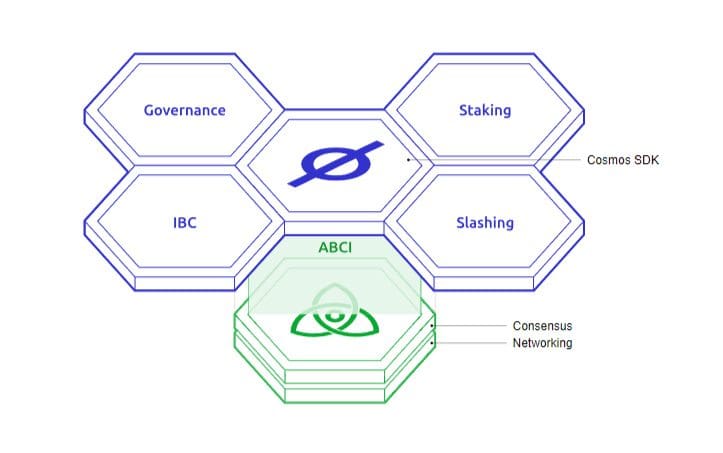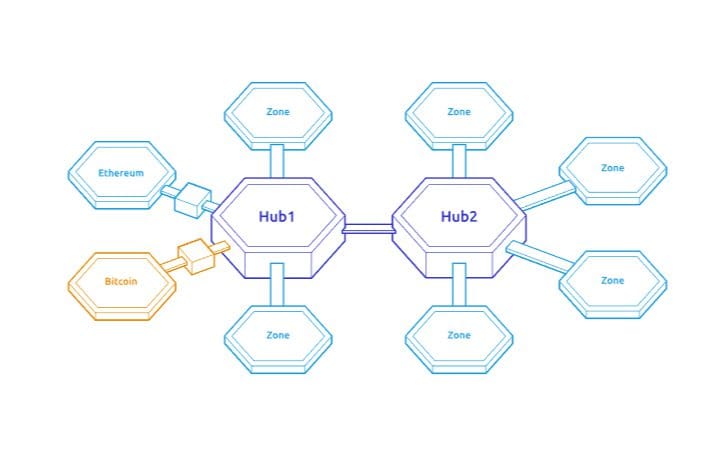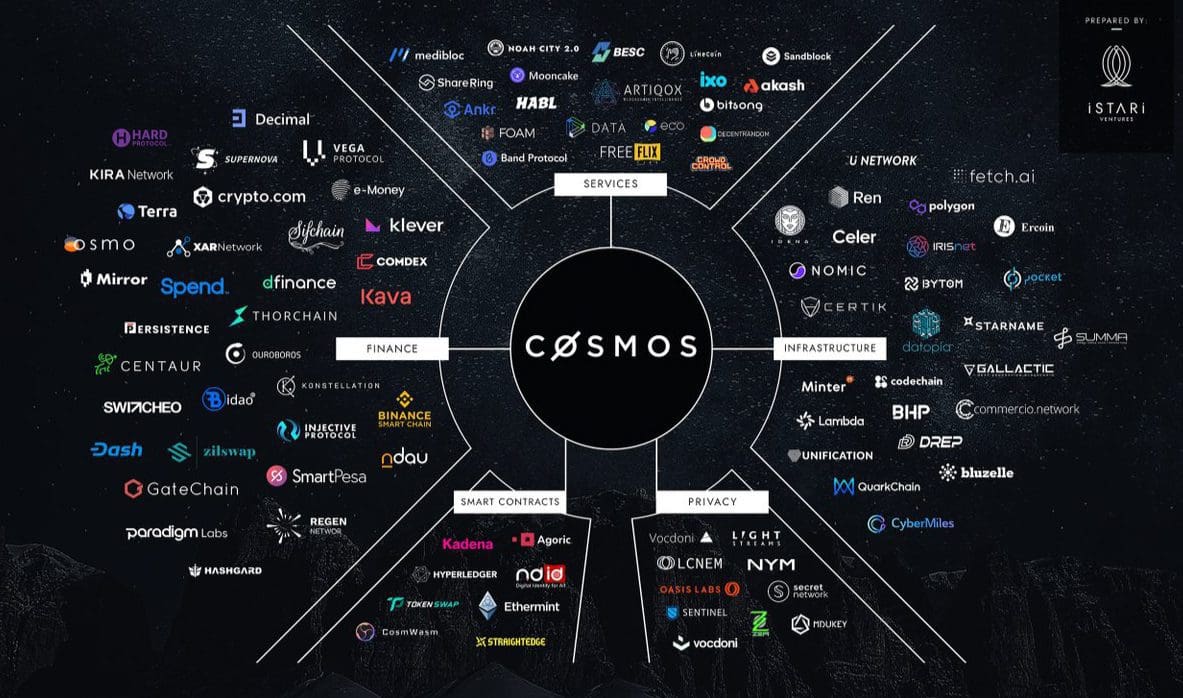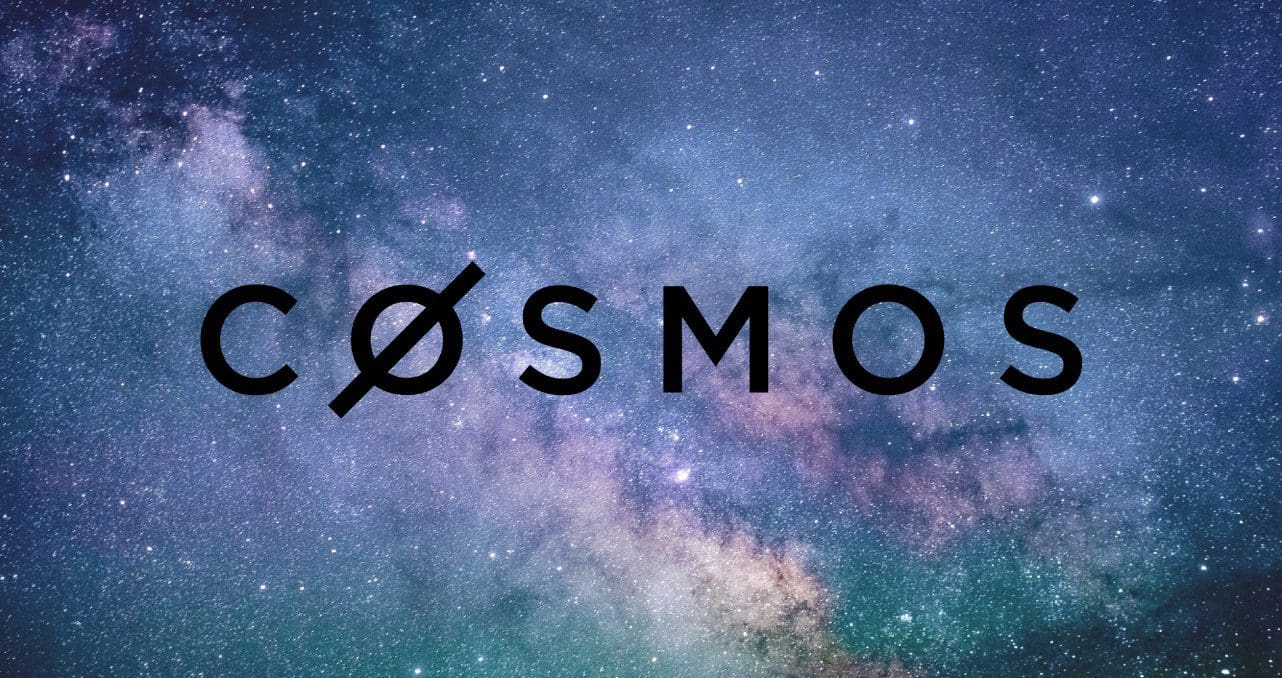Cosmos: internet of blockchains
Among the countless projects in the blockchain world, only a few deserve honorable mention; Cosmos is undoubtedly one of them. It is an original idea with high potential and aims to solve several problems of other well-known realities.
Let’s take Ethereum as an example, the place of reference for everything related to dApps and smart contracts. In fact, the most well-known and successful platforms run in this environment; Curve, Convex and MakerDAO are just a few of the most illustrious names.
However, the success of Ethereum and its projects brings several critical issues.
The first lies in customization, or rather,optimization.
Ethereum finds itself having to manage very different platforms and cannot “customize” itself according to various needs. Therefore, their development teams must compulsorily look for a compromise that brings chain and project together. Simply put, Ethereum is versatile up to a point: particular needs cannot be met.
The second weakness concerns scalability.
Ethereum has to process a huge amount of operations without any help. Beyond a certain point, the chain finds an insurmountable limit: scalability is therefore penalized, which is why several solutions have arisen that aim to offload as much work as possible from the main chain.
A further critical issue lies in the decision-making dependence of each dApp or platform on the blockchain. Governance thus encounters constraints.
These problems and limitations also inevitably fall on the user and investor: we are familiar with slow transactions, prohibitive gas fees, and difficulties in operating under certain circumstances. Not only on this chain.
The move to the Proof-of-Stake consensus algorithm and subsequent updates have improved things, but Ethereum is still a work in progress.
As always, out of problems come opportunities. The question has therefore been raised as to how we can take the best of realities such as ETH, while still going about eliminating its weaknesses.
The answer is the subject of this in-depth study: Cosmos.
Index
Cosmos: a quick look
More than a blockchain, Cosmos is a network of multiple chains that operate and communicate with each other. Because of its features, it ensures security, speed, scalability and cost-effectiveness of each transaction.
The concept behind Cosmos is simple: instead of having one blockchain that manages all the various projects, each application has its own that communicates with the entire network. Doing so does not create worlds isolated from each other but, at the same time, results in superior performance compared to the classical model.
For example, the famous DEX Osmosis has its own blockchain that manages all platform operations. However, it communicates with the Cosmos network, which benefits security and interoperability between different platforms and currencies.
As claimed by the official motto, Cosmos is thus an “internet of blockchains,” i.e., a chain network rich in projects and platforms, with no limits to scalability.
Each application can have a purpose-built environment, tailored to its needs. How is this possible? It is time to find out in detail how Cosmos works.
"Cosmos is a network of multiple blockchains communicating with each other"
How does Cosmos network work?
First, here is the official definition on what Cosmos is, so we can analyze some key words later:
“Cosmos is a decentralized network of independent parallel blockchains, each powered by BFT consensus algorithms like Tendermint consensus.”
Translated: Cosmos is a decentralized network of independent, parallel blockchains, each powered by BFT consensus algorithms like Tendermint.
Simplifying, a classic blockchain can be seen as a set of nodes where information flows. From each of them must come confirmation of that particular transaction, so that the high security standards for which this technology is distinguished can be guaranteed.

At the foundation of a blockchain is Networking, the beating heart that enables the propagation of transactions and consensus.
The Consensus is the “layer” that makes it possible to confirm transactions and ensure their veracity. More generally, it is the Consensus that makes it possible for nodes to align on the state of the system.
Above these two blocks we finally find applications. They encounter the limitations we discussed in the previous section.
Cosmos, on the other hand, is an ecosystem of different blockchains. They always work through nodes but, at the same time, are connected to each other. Doing so provides the advantages we have already mentioned and will see again below.
What is the structure of Cosmos?
The innovations of this network are achieved through several tools including Tendermint, Cosmos SDK and the IBC protocol. Let’s see what it is all about.
Tendermint BFT is the solution that makes more agile blockchain and application development possible.
On Ethereum, the introduction of EVM (Ethereum Virtual Machine) went on to make smart contract development accessible to all, giving rise to numerous dApps.
However, the blockchain remained something very difficult to fork and/or customize. The networking and consensus layers seen just now remained complex to interpret and write.
Tendermint BFT packages these two building blocks, creating a kind of engine that the developer can use both to create applications and real blockchains.
Cosmos uses this tool to be able to develop its blockchain network concept: because of the relative ease proposed, programmers can create platforms of a variety of types, each served by a dedicated chain. We are simplifying quite a bit a discourse that would be far more complex, but we do not want to get into extreme technicalities that would make for complex reading.
The acronym BFT stands for Byzantine Fault Tolerant, which is the consensus algorithm used in Tendermint BFT. It guarantees the smooth operation of the chain up to a limit of 1/3 malicious nodes in the chain. Translated: the security standard is high even in the presence of threats.
Cosmos SDK is another key piece of the network of the same name. We mentioned that Tendermint greatly facilitates the work of teams. However, building an application from scratch would still require a lot of effort…and Cosmos wants to reduce it as much as possible!
Cosmos SDK is a framework for developing quickly and easily. It is an environment in which numerous “pre-packaged” modules are available.
Depending on the needs of the project, developers can take these building blocks, combine them with each other, and modify them. Two main advantages are thus achieved:
- Not starting from scratch, but taking advantage of something ready-made;
- By not having to write the app from scratch, bugs and issues are reduced.

Frameworks are widely used in a variety of areas in the programming world. The genius idea of the Cosmos team was to create such a good one in the blockchain domain.
Cosmos SDK is highly regarded and has made possible the emergence of numerous successful projects. Last tidbit: because of its adaptability, Cosmos SDK makes it possible for developers to import EVM through Ethermint. This means one thing: bringing your own smart contracts to Ethermint effortlessly.
We now come to the IBC protocol, which stands for Inter Blockchain Communication protocol. This system allows tokens or data to be moved between different chains. To do this, blockchains have connection points between them.
The passing of tokens takes place in several stages and aims to ensure security and regularity, while theCosmos ecosystem allows users to move tokens with ease, without the need for bridges or synthetic assets.
To sum up: what is Cosmos and how is it structured?
Cosmos is an innovative project that solves several problems present in so many other realities. It creates a blockchain network and does so with the tools provided by the underlying triad: Tendermint, Cosmos SDK and IBC protocol.

The structure of Cosmos is depicted in the image above.
Hubs are blockchains built for the purpose of connecting different Zones to each other. Zones, on the other hand, are blockchains that are heterogeneous with each other and built to serve equally diverse purposes.
The first hub launched is the Cosmos Hub, a chain that uses the Proof-of-Stake consensus algorithm and has ATOM as its coin. We have finally reached this point.
Potentially, any blockchain can interact with the Cosmos ecosystem. Let’s look at the benefits of this project in more detail.
"Cosmos is an innovative blockchain network with a bright future"
The strengths of Cosmos
Already mentioned several times, here are the advantages of the Cosmos environment.
Scalability
Each application has its own blockchain. By doing so, congestion is avoided and superior performance is achieved.
In addition, each chain is built according to the needs of the project and can be modified without particular difficulty. At the level of evolution, this is a huge strength.
Security
Thanks to the system, each individual blockchain enjoys high security.
Interoperability
Each blockchain is autonomous but that does not mean it is isolated. Cosmos is designed precisely to foster interoperability between them, but without going to the detriment of their independence.
Governance
Because each chain has its own life, decisions can be made completely autonomously.
Coin and data exchange
Cosmos integrates the IBC and allows users to move coins easily between chains; all without complex procedures and synthetic assets.
ATOM coin
Here we come to ATOM, the Cosmos Hub coin.
The maximum supply is infinite and, at the time of the update is around 391 million.
At one time, the intrinsic value left some doubt. In fact, usually, a chain uses its own coin to pay gas fees: Ethereum has ETH, Bitcoin BTC, Solana SOL.
Because of this feature, users using the blockchain in question must purchase the relevant currency to trade, helping to increase the demand (and consequently the price) for it.
Given the particular construction of Cosmos, each chain has its own token designated for the payment of gas fees. Therefore, ATOM found itself in a somewhat awkward situation.
Over time, however, important announcements were made. ATOM gained relevance in managing and improving the security standards of the network, thus gaining more intrinsic value.
The market reacted well, bringing the coin to touch levels above $40 per specimen. However, abetted by the long crypto winter of 2022, ATOM never approached similar figures again.
To invest or not to invest? The usual note always applies: everyone should do their own research on the fundamentals.
The ATOM Cosmos coin can be purchased on major exchanges such as Crypto.com, Bitget, Bybit, Binance and Kraken. Here is the TradingView chart to view its real-time performance:
Interesting projects built on Cosmos
If we set out to list them all, this article would take a long time to read.
Let us therefore limit ourselves to a couple of names of the major projects that exploit the Cosmos ecosystem.
First, Osmosis, the benchmark DEX AMM for investing in ATOM. The cartoonish style should not deceive: it is a serious and well-developed DeFi platform.
Between farm and staking you can get very good returns, paid in the OSMO token (also used for fees). We discovered this in the article dedicated to Osmosis.
Are you looking for dedicated smart contract solutions, especially from an interchain perspective? Juno is the best choice.
Now let’s stop and note the differences from the usual.
Normally we list the various platforms of a blockchain. For example, when talking about Solana we mentioned Marinade Finance and Raydium.
In this case we are instead mentioning very different realities. Not to mention that we have not mentioned realities such as Ankr, Binance Smart Chain and THORchain. It was also the structure behind Terra (the failure of the project was absolutely not because of Cosmos). This is because, as we said, Cosmos is a network, not just a blockchain.
Thus, within it we find a universe full of projects all to be explored.

Cosmos network: don't call it blockchain!
After what has been said, it is impossible not to be impressed by how innovative Cosmos network is and how it is able to eliminate the limitations of the classic blockchain.
The network that comes into being is vibrant, full of projects that manage to develop to the fullest precisely because of the system offered by Cosmos. In these times of growth of the whole blockchain and crypto landscape, this reality seems to want to maintain an important role.
It will benefit so many parts of the network as well as users. Also not to be forgotten are the investors in ATOM who who knows, maybe they might smile again.
Cosmos network has all the credentials to continue its journey and increasingly become one of the pillars of the blockchain world.

